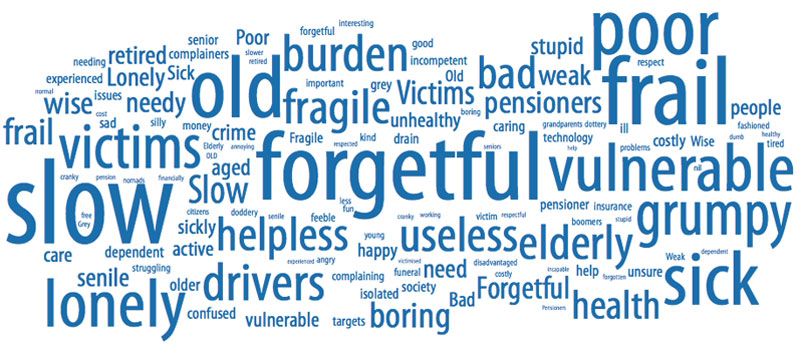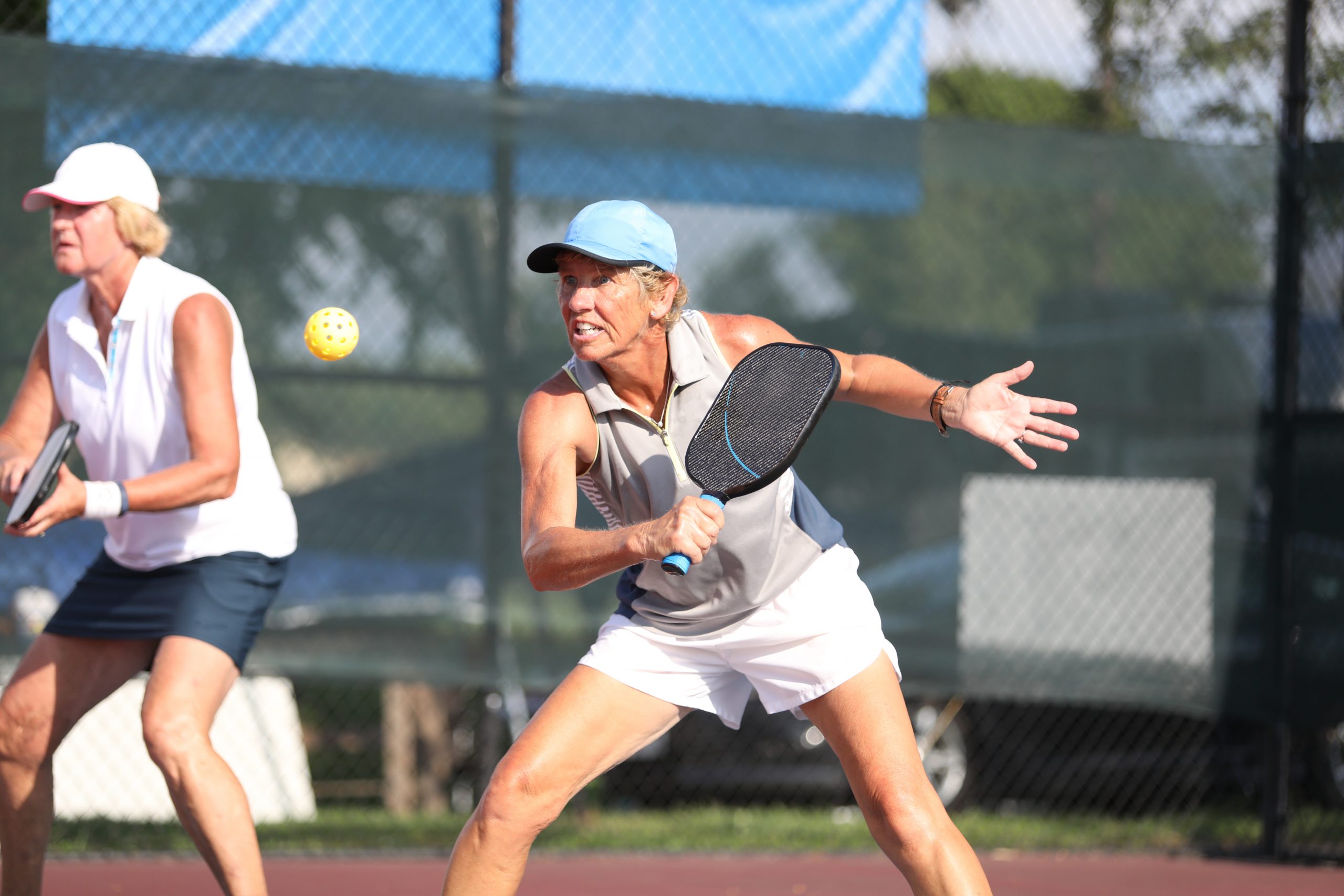6
Section One: The Fundamentals
A) Keywords
Exercise 1:
Provide a brief definition of one of the padlet keywords for this week.
| The number of third-age societies is increasing, and their members are expected to live past 70 years old. It is the first stage of old age, with the second being the fourth age. It is analogous to retirement, or the withdrawal from paid work, but the maintenance of good health and an active lifestyle. |
B) The Social Significance of Aging in Sport
Exercise 2: Notebook Prompt
How is old age popularly represented today? Find an image online that you think exemplifies one defining attitude towards old age and paste in your notebook below with a brief explanation of what this image means to you

| I believe this image encompasses one way that old age is popularily represented. This image is a word cloud of several negative representations and affiliations of old age, such as being frail, fragile, forgetful, and helpless. Generally in medicine which is the field of work I am starting next year, many patients are older, and are in poor health, exhibiting many of the traits found on this image. As a future physician, it is important for me to remember that this is not representative of all older people, and the goal is to restore them to be best of my ability, back to their optimal health so they do not exhibit any of these traits. |
Exercise 3: Notebook Prompt
What does the article (referencing another study by Dionigi) mean by its statement that sport can help aging people to simultaneously “accept and resist the ageing process” (572)? Respond by audio or text and find paste two images sourced online into your notebook showing how sport might help aging people to both accept and resist the aging process.
| I think ageing is a complex process, and one that people grapple with for years, while never fully understanding, or come to terms with it. Many people experience a lot of conflict when thinking about aging. They can accept it by adjusting their approach to sport. Take the first picture for example, where people are playing pickleball. Pickleball is a very popular alternative to tennis, played at a slower pace for the recreational level and on a smaller surface, thereby requiring less movement. On the other hand, this sport allows older people to continue to participate in a modified form of a sport they love, with a very similar style of play and allowing them to stay active and do something they love. At the same time, they can resist this aging process by continuing to play sports, despite having diminished mobility and less strength. They can persevere through this to ignore the aging process. Another example, I think can be seen through the second image, but more resisting aging. By continuing to run despite advancing age, he is trying to stay in shape and prevent any loss of ability and strength, and continuing to do things that he maybe did at a younger age because he is in denial about his age. |


Exercise 4: Notebook Prompt
Who are the groups less likely to have extensive opportunities to take part in sports, according to Pike? How does privilege factor into aging and sport? (200 words max)
| Some groups less likely to get extensive opportunities include those with disabilities, frail individuals, ethnic minorities, those living in long term care and those living in rural areas. Privilege is an important factor regarding access to sports, unfortunately. Those with lower privileges face barriers to their participation, from geographical, to financial barriers, such as them being too far away, or too poor to pay for sports, as enrolment in sports can cost a lot. People who are not able to afford sports, could be subject to a sedentary lifestyle, which can cause their health to deteriorate faster, and the aging process to have a more pronounced effect on one’s lifestyle, bringing in the more negative aspects of aging. Privilege is directly intertwined with one’s ability to participate in sport. Those with less privilege may also have less time and resources to participate in sport, as they may be forced to spend more time working, to get money for basic survival and resources, as opposed to spend for sport participation. To disassociate privilege and sport to help with the aging process, it is important to make every possible effort to close the gap between privilege levels and remove barriers. |
Exercise 5: Padlet Discussion
Why do you think age discrimination is “reported more than any form of prejudice” with older people presented as a threat to social values and interests? Feel welcome to use video in your responses. Paste your comments (or transcript of your video) below!
| Age discrimination is reported more than any other form of prejudice. One of the reasons for this I believe is people are in denial about aging, which everyone will experience. Putting people down for being older, holding preconceived notions about about their abilities and skills somehow helps society cope with the idea that eventually, everyone will get to that point. Another reason that ageism is so common is that society values efficiency and money over a lot of things. As older people do not work, they are viewed as not contributing to society. They are also perceived as as slow and get in the way. Between these two preconceptions about older people, they will get in the way of production in society. This means they may get neglected and disliked by many people. After people enter the third stage and step away from work, hindering their contributions to the economy and society, they eventually begin to require more resources for health care, including hospital stays and doctors visits. They may also require social and financial aid. When people stop working, the income stops and they would need more resources given to them. For social support, many psychological disorders have an increase in prevalence as people age, which also applies to medical disorders. |
B) Older Women and Sport
Exercise 6: Notebook Prompt
What differences do you see in these ads? Which one is more inclusive? How is age represented or not represented in each? Answer these questions in your notebook.
| The more inclusive ad is the first one, which addresses several different minorities, including racialized minorities, those with disabilties and older populations. The first difference is that instead of just showing women in sports, the first one had a broader focus, including the aforementioned. Another different the first advertisement is focused on unity in sport among minorities, calling for them all to come together and fight against injustices by competing even harder in sports. I would, however, argue that age is not represented as well in the first ad. It is much better represented in the second one, with athletes of many different ages shown in the ad. In the first one, most of the athletes are profession ones, other than two children playing tennis in the living room during the COVID part of it. Another difference is that in the second one, still a very effective ad, it calls on women, and raises awareness for sexist discrimination as female athletes are still very highly skilled athletes and consistently maintaining a strict training schedule to be at their best. The second ad also encompasses various skill levels, from amateur all the way up to professional levels, demonstrating that skill levels are not as relevant and just because someone has a lower skill level, does not make them any worse of an athlete. |
Exercise 7: Notebook Prompt
In her article, “Assessing the sociology of sport: On age and ability,” Elizabeth Pike references a “trend towards a ‘feminisation of ageing’, with many women living longer than men” (573). Do you agree that aging has been “feminized” in this way? How? Answer these questions in your notebook.
| I do agree that aging is becoming more feminized, as it is a fact that women are living longer than men, and outnumber them in the oldest age groups. The oldest few people in the world are also women, I believe, which provides another example. However, as women age, they experience some more discrimination. This seems to occur because advancing age is viewed as a burden, demonstrating that ageism is experienced more by women. It can be experienced due to one’s physical appearance, which tends to decline as one ages. This can be another unfortunate example of feminization. Due to this, older women tend to feel the need to act more energized in order to have a shot at getting, or keeping a job. Another possible example is that when companies let people go, they tend to be the older, or more tenured employees for a couple reasons. First, and foremost, they normally get paid more, and are more of a drain on company finances, and they maybe would not do as good of a job as a new person, that is younger and faster-moving and more efficient. |
Section Three: Module Mini Assignment
The city of Peterborough wants to put several pickleball courts and tennis courts into a park in the city. This has the neighbours in an uproar. This is because instead of having a free space for people to be active, they are paving over it and making it into a structured region of the city, with little room for free use, and no representation of the natural environment. This will make quiet area much busier with foot traffic. It has begun to spark a social movement and protests towards trying to save the park from redevelopment (Johnston, 2024). In a Facebook post by Ingrid Hall, she provided an update saying that the lawyer they were going to use could not attend court, so the city won the case and went ahead with the demolition of the park to prepare for building all the courts and paving over all the green space. I do not believe older advocates are as well represented in media discussions as normally, they are not as up to date with social media uses and technology as a younger proportion of the population. In terms of neoliberalism, the courts themselves are a form of controlling where people can play. Part of the Facebook threads involved people asking for a bylaw prohibiting the use of whiffleballs, normally used in pickleball to provide more quiet play. I believe these can be seen to attempt to exert more control over the elderly, the dominant demographic of pickleball. The article brings up that these spaces are meant for a particular activity, instead of free space. Finally, neoliberalism is seen through building of these courts can minimize government spending for upkeep. Instead of constant maintenance required for mowing, they pay a one-time fee and then ignore it for a long time.

